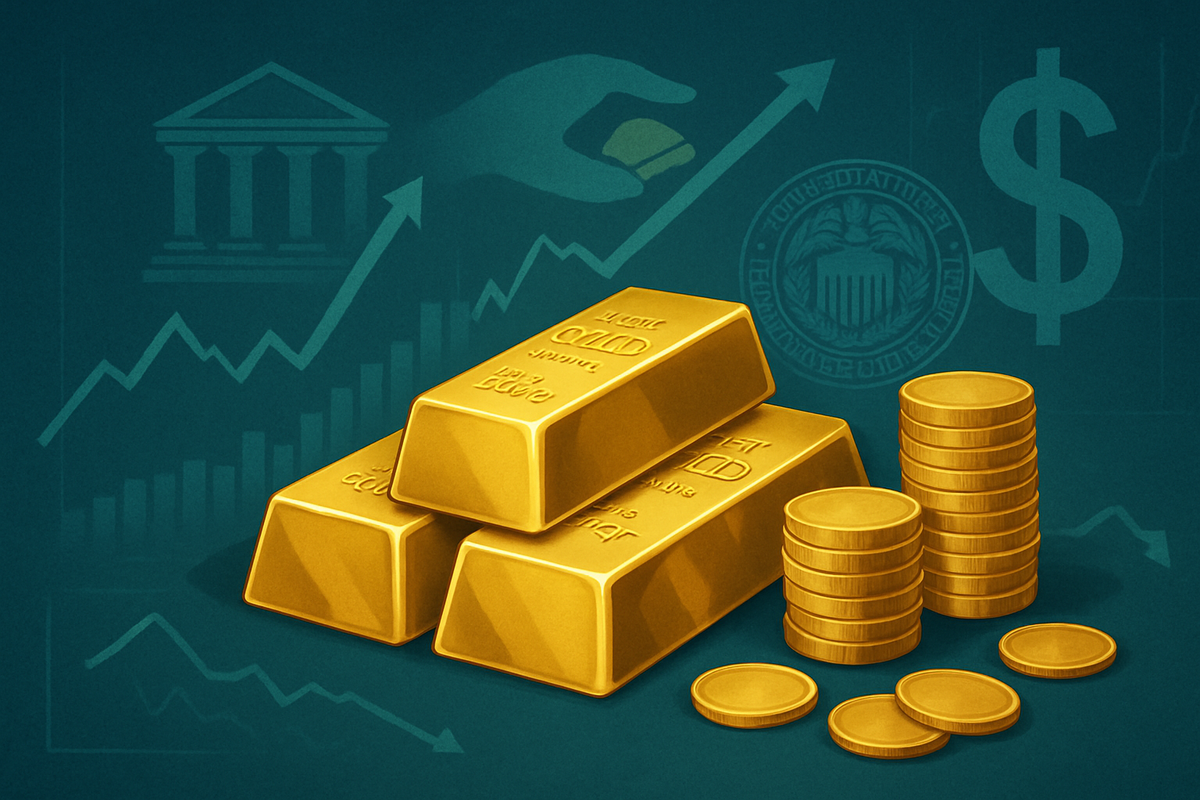Gold's Golden Ascent: Fed Rate Cut Hints and Central Bank Hoarding Drive Prices Amidst Dollar Volatility

October 9, 2025 – The global gold market is experiencing an unprecedented rally, with prices soaring to record highs, largely fueled by the Federal Reserve's dovish pivot and an insatiable appetite for the yellow metal from central banks worldwide. Despite a recent modest retreat from its peak levels, gold remains a focal point for investors navigating a landscape of economic uncertainty and geopolitical tensions. This surge reflects a fundamental shift in global monetary policy and reserve management, positioning gold as a critical safe-haven asset in an an increasingly unpredictable financial environment.
The interplay of anticipated interest rate cuts by the U.S. Federal Reserve, a sustained trend of central bank gold accumulation, and the fluctuating strength of the U.S. dollar are the primary forces shaping gold's trajectory. While the prospect of lower interest rates reduces the opportunity cost of holding non-yielding gold, robust central bank purchases provide a strong floor for demand. The dollar's performance, often inversely correlated with gold, adds another layer of complexity, with its recent softening contributing to gold's allure for international buyers.
Detailed Market Dynamics and Influential Factors
Gold has embarked on a remarkable journey in 2025, shattering previous records and reaching unprecedented highs. The precious metal surpassed the significant $4,000 per ounce mark, with reports indicating peaks around $4,059.05 to $4,078 per ounce. This meteoric rise represents an astounding gain of approximately 53-54% year-to-date. As of October 9, 2025, gold has seen a slight consolidation, hovering around $4,040 per ounce. This modest pullback is largely interpreted as a natural profit-taking event after such a rapid ascent, rather than a fundamental shift in market sentiment.
The Federal Reserve's monetary policy has been a pivotal catalyst. Following a period of tightening, the Fed initiated its first interest rate cut since late 2024 in September 2025. Critically, the central bank has signaled intentions for two additional 25-basis-point cuts before the year's end, with market participants pricing in a high probability (around 94% and 79% respectively) for cuts in October and December 2025. This dovish stance, aimed at countering slower economic growth and a weakening job market, diminishes the attractiveness of interest-bearing assets and, consequently, boosts gold's appeal by lowering its opportunity cost.
Concurrently, central banks globally have been on an aggressive gold buying spree, a trend that commenced in 2022 and has only intensified through 2025. This sustained accumulation acts as a powerful structural support for gold prices. In the first three quarters of 2024, central banks collectively purchased 694 tonnes of gold, maintaining the robust demand observed in prior years. By the second quarter of 2025, net purchases totaled 166 tonnes. This strategic diversification away from the U.S. dollar, driven by a desire for durable, portable, and politically neutral reserve assets, has led to a historic milestone: foreign central banks' gold reserves have surpassed their holdings of U.S. Treasuries for the first time since 1996. Leading buyers include nations like Turkey, China, Poland, India, and Russia, reflecting a broader geopolitical shift.
The U.S. dollar's strength plays a crucial, albeit often inverse, role in gold's valuation. Generally, a weaker dollar makes gold more affordable for international buyers, thereby increasing demand. The anticipation of Fed rate cuts has contributed to a softer U.S. dollar, which has been supportive of gold's rally. However, any unexpected strengthening of the dollar, particularly if driven by factors beyond interest rate differentials or if it signals a tightening of global financial conditions, could exert downward pressure on gold prices, creating a dynamic tension within the market.
Corporate Winners and Losers in the Golden Rush
The current gold market environment creates significant implications for public companies, particularly those involved in gold mining, exploration, and investment. Companies with strong gold exposure stand to benefit significantly from elevated prices, while those more sensitive to dollar strength or economic slowdowns might face headwinds.
Gold mining companies are direct beneficiaries of rising gold prices. Major players such as Barrick Gold (NYSE: GOLD) and Newmont (NYSE: NEM) are seeing their revenues and profit margins expand. Higher gold prices improve the economics of existing mines, potentially extending their operational lives, and make previously uneconomical deposits viable. This can lead to increased exploration budgets and production targets. However, these companies also face challenges such as rising input costs (energy, labor) and regulatory hurdles, which can temper the benefits of higher gold prices. Smaller, junior mining companies with promising projects could also attract significant investor interest and capital, potentially leading to acquisitions or joint ventures.
Investment vehicles like gold exchange-traded funds (ETFs), such as SPDR Gold Shares (NYSEARCA: GLD), are also direct beneficiaries. These funds provide investors with a liquid way to gain exposure to gold prices without physically holding the metal. Increased investor interest in gold as a safe haven or inflation hedge translates directly into higher assets under management and potentially higher share prices for these ETFs. Similarly, companies that provide gold streaming and royalty financing could see increased cash flows as their underlying assets appreciate in value.
Conversely, companies whose business models are negatively impacted by a weaker U.S. dollar or by the broader economic conditions that necessitate Fed rate cuts could face challenges. For example, some multinational corporations that primarily generate revenue in foreign currencies but report in U.S. dollars might see their earnings diluted by a weaker dollar. Furthermore, if the economic slowdown prompting Fed rate cuts deepens, companies across various sectors could experience reduced consumer spending and business investment, regardless of their direct exposure to gold. However, the overall sentiment that drives gold prices often reflects a flight to safety, which can indicate broader market stress that affects many companies negatively.
Wider Significance and Historical Context
The current gold rally transcends mere commodity market fluctuations; it reflects profound shifts in global monetary policy, geopolitical dynamics, and investor sentiment. The Federal Reserve's pivot towards monetary easing, coupled with aggressive central bank gold purchases, signals a broader trend of de-dollarization and a strategic re-evaluation of reserve assets by nations worldwide. This event fits into broader industry trends emphasizing tangible assets and diversification away from traditional fiat currencies, particularly the U.S. dollar, amidst concerns about inflation and financial stability.
The ripple effects are significant. Beyond gold, other precious metals like silver and platinum often follow gold's lead, benefiting from similar safe-haven and inflation-hedge characteristics. The sustained demand for gold by central banks also has implications for the international monetary system, potentially leading to a more multipolar reserve currency landscape over the long term. Regulatory bodies and policymakers are closely watching these developments, as a significant shift in reserve asset composition could influence global financial stability and trade dynamics. The move by central banks to hold more gold than U.S. Treasuries for the first time in decades is a powerful statement about perceived risk and future currency valuations.
Historically, gold has served as a reliable hedge against inflation and economic uncertainty. During periods of high inflation or geopolitical turmoil, gold prices typically surge as investors seek refuge. Comparisons can be drawn to the 1970s, a decade marked by high inflation and geopolitical instability, where gold prices experienced a dramatic increase. More recently, the aftermath of the 2008 financial crisis and the COVID-19 pandemic also saw significant gold rallies as central banks engaged in quantitative easing and investors sought safety. The current environment, characterized by persistent global economic uncertainty, a slowing job market, and ongoing geopolitical conflicts, echoes these historical precedents, reinforcing gold's role as a safe-haven asset. The strategic shift by central banks to diversify reserves also has parallels to historical periods where nations sought to reduce reliance on a single dominant currency.
Navigating the Future: What Comes Next
The trajectory of gold prices in the coming months and years will largely depend on the continued actions of the Federal Reserve, the persistence of central bank buying, and the overall health of the global economy. In the short term, the market is keenly focused on the Fed's anticipated rate cuts in October and December 2025. Should these cuts materialize as expected, or if the Fed signals an even more aggressive easing path, gold is likely to find further support, potentially re-testing its recent peak levels. Conversely, any hawkish surprises from the Fed or an unexpected strengthening of the U.S. dollar could trigger a more pronounced correction.
In the long term, analysts project continued strong investor and central bank demand. Forecasts suggest gold could average around $3,675 per ounce by Q4 2025, with some optimistic outlooks predicting a rise to $4,000 per ounce by Q2 2026, and even as high as $4,900 per ounce by December 2026, barring significant shifts in global economic growth or dollar strength. This indicates a belief in the sustained relevance of gold as a store of value. Strategic pivots for investors might include maintaining a diversified portfolio with a healthy allocation to gold, considering its role as an inflation hedge and a safe haven. Central banks are likely to continue their diversification efforts, further cementing gold's role in global reserves.
Market opportunities may emerge in specific segments, such as gold mining stocks with strong balance sheets and low production costs, or specialized gold ETFs that offer leveraged exposure or focus on specific geographic regions. Challenges include potential volatility stemming from unexpected economic data, geopolitical events, or shifts in central bank rhetoric. Potential scenarios range from a continued bullish run if global uncertainties persist and the Fed remains dovish, to a more sideways consolidation if economic conditions stabilize and the dollar strengthens. A more bearish scenario, though less likely given current trends, would involve a rapid economic recovery and aggressive rate hikes, which would diminish gold's appeal.
Comprehensive Wrap-Up: A Resilient Golden Future
The current gold market rally is a multifaceted phenomenon driven by the strategic interplay of the Federal Reserve's monetary policy, unprecedented central bank gold accumulation, and the fluctuating strength of the U.S. dollar. Key takeaways include gold's remarkable ascent to record highs, its role as a primary beneficiary of dovish Fed policy, and the foundational support provided by global central bank diversification efforts. The recent retreat from peak levels is largely seen as a healthy market consolidation rather than a reversal of the underlying bullish trend.
Moving forward, the market is poised for continued vigilance. The Federal Reserve's future rate decisions will remain a critical determinant of gold's short-term movements, while the long-term structural demand from central banks provides a robust floor. Investors should assess gold's position within their portfolios, considering its historical performance during times of economic uncertainty and its potential as a hedge against inflation and currency devaluation. The shift in central bank reserve preferences, with gold surpassing U.S. Treasury holdings, underscores a fundamental re-evaluation of global financial stability.
What investors should watch for in the coming months includes the precise timing and magnitude of further Fed rate cuts, any changes in the pace of central bank gold purchases, and key economic indicators that could influence the U.S. dollar's strength. Geopolitical developments will also continue to play a significant role, as heightened tensions often increase demand for safe-haven assets. The current environment suggests that gold's significance as a strategic asset is likely to endure, making it a crucial component of financial discourse and investment strategies for the foreseeable future.
This content is intended for informational purposes only and is not financial advice
More News
View More




Recent Quotes
View More
Quotes delayed at least 20 minutes.
By accessing this page, you agree to the Privacy Policy and Terms Of Service.